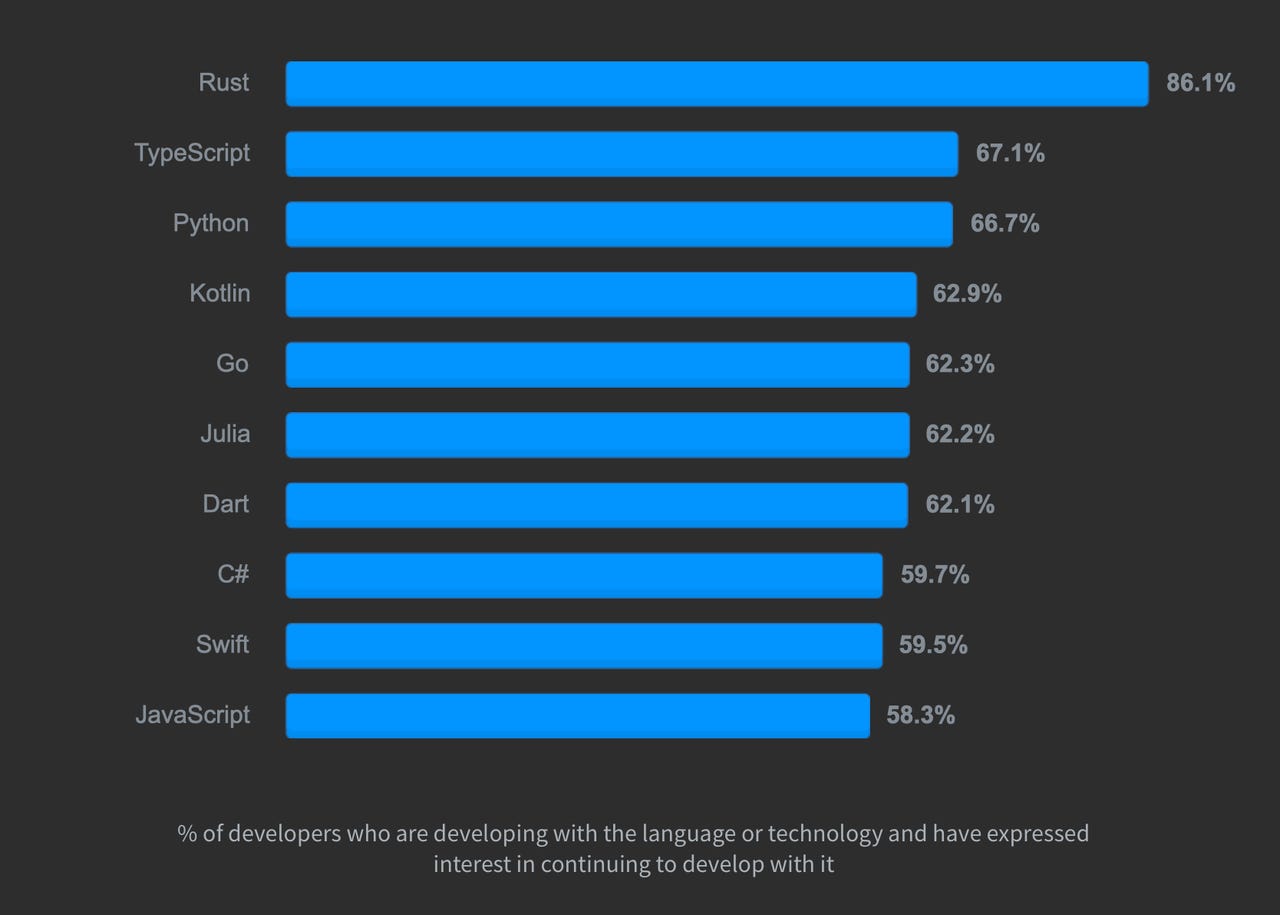Programming languages, IT spending, cybersecurity risks, and more: ZDNet's research round-up


Most popular programming languages of 2020
Coding question-and-answer site Stack Overflow has released the results of its 2020 survey of nearly 65,000 developers, revealing their favorite and most-dreaded programming languages, tools and frameworks. The survey shows that TypeScript, Microsoft's superset of the widely used JavaScript programming language, has overtaken Python as the second-most-beloved programming language behind Rust. This year 86% of respondents say they are keen to use Rust, while 67.1% want to use TypeScript, and 66.7% want to use Python.
For more see: Programming languages: Developers reveal what they love and loathe, and what pays best
Coronavirus continues to impact tech industry
COVID-19 continues to cause suffering worldwide and the pandemic is expected to continue causing economic disruption on an international scale. Research firm Gartner has revised its worldwide IT spending predictions from $3.9 trillion over 2020 to $3.4 trillion. Device shipments have received a further amendment, with expenditure relating to PCs, tablets, and mobile devices set to decline by 13.6% in 2020, totalling 1.9 billion units in comparison to approximately 2.2 billion units in 2019.
SEE: Coronavirus continues to impact tech industry, worldwide device shipments to plummet 14%
CFOs confident in reconfigured offices, but employees wary
CFOs are becoming more confident that they can safely implement back-to-work plans with reconfigured offices and safety procedures, but employees are not so sure, according to the latest PwC CFO survey. Among CFOs, 47% are very confident they can manage their employees' wellbeing and morale. Yet 61% of workers are concerned about their employer using a wearable device to track location and proximity to those infected, 52% worry about workplace cameras, and 49% are concerned about required COVID-19 testing.
For more see: CFOs confident in reconfigured work, processes, offices, but employees wary, says PwC survey
Galaxy A51 tops Android sales in the first quarter
Samsung's recently released mid-range Galaxy A51 has been the top-selling Android phone globally in the first quarter of 2020. Samsung shipped six million Galaxy A51 4G smartphones in the quarter, giving it 2% of the overall Android market, according to Strategy Analytics. Global smartphone shipments reached 275 million units in the quarter, of which Android phones made up 86%.
For more see: Top Android smartphones: These are the best-selling phones in the 'post-premium era'
Smartphones, laptops, IoT devices vulnerable to new BIAS Bluetooth attack
Academics disclosed a new vulnerability in the Bluetooth wireless protocol, broadly used to interconnect modern devices, such as smartphones, tablets, laptops, and smart IoT devices. The vulnerability, codenamed BIAS (Bluetooth Impersonation AttackS), impacts the classic version of the Bluetooth protocol. The research team tested the attack against a wide range of devices. Vendors of Bluetooth devices are expected to roll out firmware updates in the coming months to fix the issue.
For more see: Smartphones, laptops, IoT devices vulnerable to new BIAS Bluetooth attack
‘Flight risk’ employees involved in 60% of insider cybersecurity incidents
Employees planning to leave their jobs are involved in 60% of insider cybersecurity incidents and data leaks, new research suggests. According to the Securonix 2020 Insider Threat Report, "flight risk" employees, generally deemed to be individuals on the verge of resigning or otherwise leaving a job, often change their behavioural patterns from two months to two weeks before conducting an insider attack. In total, 43.75% of insiders forwarded content to personal emails.
For more see: 'Flight risk' employees involved in 60% of insider cybersecurity incidents
CXOs are the weakest link in mobile device security
A new study by MobileIron reveals that C-level executives feel frustrated by mobile security protocols and often request to bypass them. The study shows that over two-thirds (68%) of C-level executives believe IT security compromises their personal privacy, and over three in five (62%) say security limits the usability of their devices. One in six (16%) have requested to bypass one of the organisation's security protocols over five times.
For more see: CXOs are the weakest link in mobile device security and most likely to suffer cyber attacks
Diversity in AI improves, but has further to go
Ninety-one percent of AI professionals say increased diversity is having a positive impact on AI technology, but opinions vary based on country as well as gender, according to an IBM study. The research says 85% of global AI professionals believe the industry has become more diverse in recent years. Most respondents say that diversity has had a positive impact on AI technology. The poll covers a sample of 3,221 AI professionals in US, Canada, India, and Europe.
For more see: Diversity in AI improves, but has further to go, according to IBM survey
Adoption of AI in marketing has tripled from 2018 to 2020
A winning digital marketing strategy includes artificial intelligence (AI), according to the "State of Marketing" report from Salesforce. A whopping 84% of marketers report using AI - up from 29% in 2018. As many as 70% of high-performing marketing organisations have a fully defined AI strategy.
For more see: State of Marketing 2020: Innovation is top priority with 186% increase in AI adoption since 2018
Augmented reality and 3D will accelerate adoption of e-commerce
Visual e-commerce, a combination of augmented reality and 3D rendering will improve the user experience this year, according to research from visualization-platform specialist Threekit. COVID-19 has boosted the perceived value of the technology. With retail stores closed, the only option available has been e-commerce. Threekit has seen forward-thinking companies accelerate their pipeline to offer digital alternatives to shopping in-store in order to meet consumers' growing dependency on e-commerce.
For more see: Augmented reality and 3D will accelerate adoption of e-commerce
E-commerce surge for home goods due to COVID-19
Wayfair's first quarter revenue jumped nearly 20% as customers used the online furniture retailer to equip home offices and buy home goods amid the COVID-19 pandemic. The company's logistic and supply chain held up well as rival brick-and-mortar retailers were shut down. In the first quarter, Wayfair said revenue was $2.3 billion, up $385.2 million and 19.8% from a year ago. Active customers for the direct retail business hit 21.1 million as of March 31.
For more see: Wayfair's Q1 shines as it hits 21.1 million active customers as e-commerce surges for home goods
Logitech benefits from webcam, video collaboration demand boom
If you were trying to get a new webcam in recent weeks, you know that supply was tight - and now we have proof that webcam sales were off the charts via Logitech earnings. Logitech reported fourth quarter sales of $709 million, up 14% from a year ago, with net income of $214 million, or $1.26 a share. What really catches the eye is how the move to home offices bolstered Logitech. Webcam sales were up 32% in the fourth quarter. Video collaboration sales in the fourth quarter were up 60% and keyboard sales were up 13%.
For more see: Logitech benefits from webcam, video collaboration demand boom